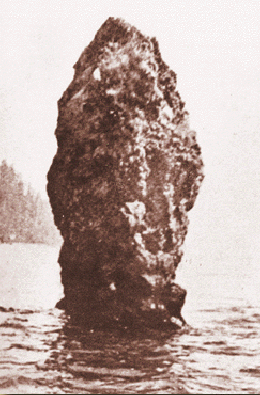On November 7, 1805, thinking he can see and hear the Pacific Ocean in the distance, William Clark writes his most famous journal entry: "Great joy in camp we are in view of the Ocian, this great Pacific Octean which we have been so long anxious to See." In fact, the Lewis and Clark Expedition is still 20 miles from the sea.
The explorers camped at a site west of Jim Crow Point in present-day Wahkiakum County, opposite a 70-foot high basalt column that still bears the name they gave it: Pillar Rock. The column (now topped with a navigational beacon) sits in about 50 feet of water roughly a mile from the shore. The ocean cannot be seen from this point, but the river widens to four or five miles and is subject to tidal action that can easily be mistaken for ocean waves.
Whether they could actually see the ocean or not, Captains Meriwether Lewis (1774-1809) and William Clark (1770-1838) and the 30-plus members of their expedition knew that they were approaching the end of their long journey to the Pacific Coast. Clark could not contain his elation at seeing the broad expanse of water before him. "Ocian in view! O! the joy," he wrote in the field notebook that he kept on his knee to record courses and bearings while afloat. Adding up the miles that night, he calculated that the expedition had traveled 4,142 miles from the mouth of the Missouri River to the mouth of the Columbia.
The elation soon dissipated in the face of high winds and crashing waves that kept the expedition pinned against the shoreline for a week. Several members of the party, including Sacagawea, suffered from seasickness whenever they ventured out on the water. They crossed into what is now Pacific County, huddling at a campsite in Megler Cove, just west of the Megler Visitors Information Center. At high tide, the canoes filled with water and slammed against waterborne trees that were up to 200 feet long and seven feet in diameter. Clark called the spot "Dismal nitch," no doubt reflecting the entire party’s state of mind.
Their bedding and clothing, most of it made from animal skins, rotted in the rain. Food supplies ran low. Through it all, it rained. "…from the 5th in the morng. untill the 16th is eleven days rain," Clark complained, "and the most disagreeable time I have experenced confined on a tempiest coast wet, where I can neither git out to hunt, return to a better situation, or proceed on…" (November 15, 1805).
Several times groups of Chinook Indians visited the bedraggled expedition, negotiating the turbulent estuary with a skill and elan that amazed the Missouri rivermen. "Those Indians are certainly the best Canoe navigaters I ever Saw," Clark wrote, after watching one group paddle off through "the highest waves I ever Saw a Small vestles [vessel] ride" (November 11, 1805).

